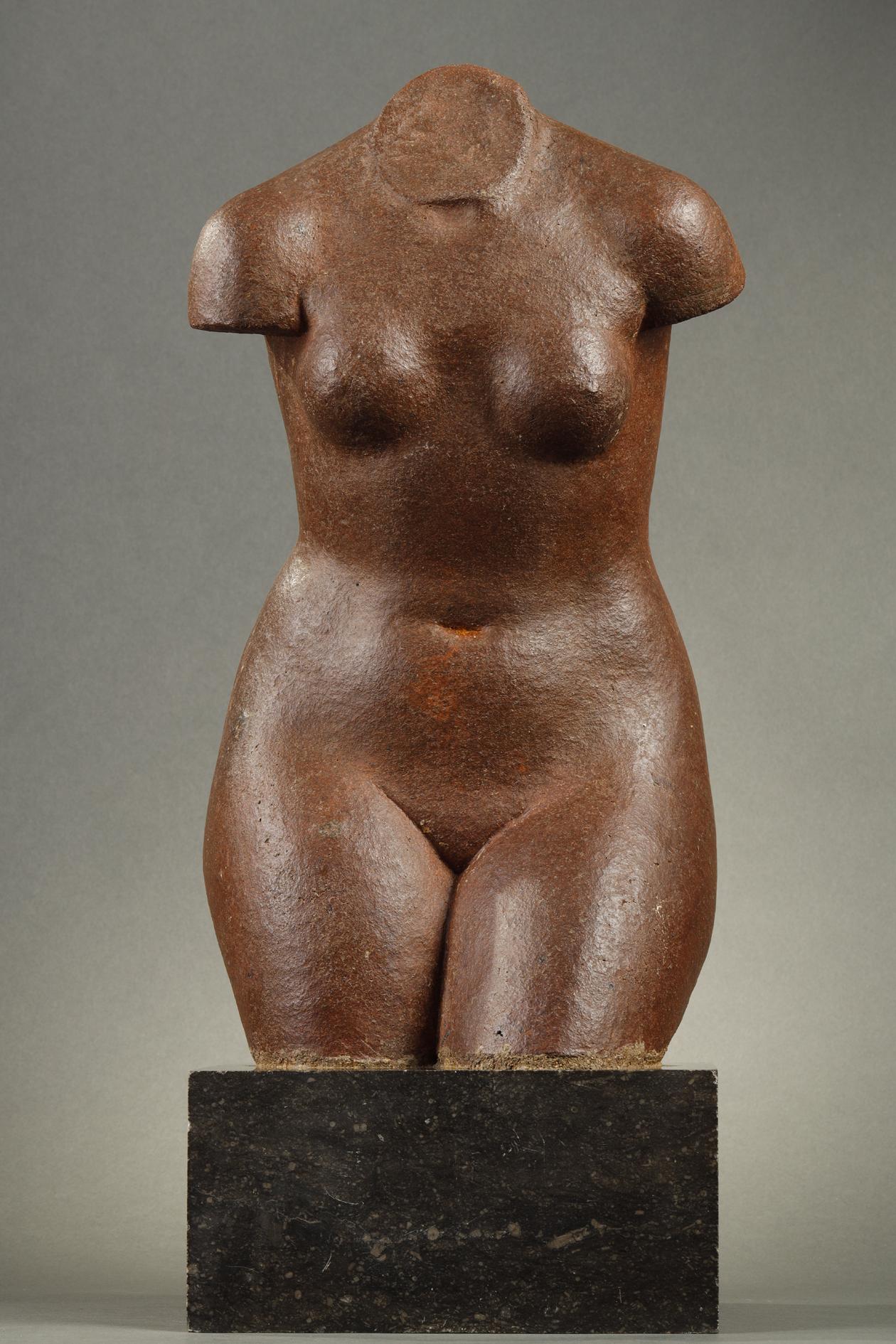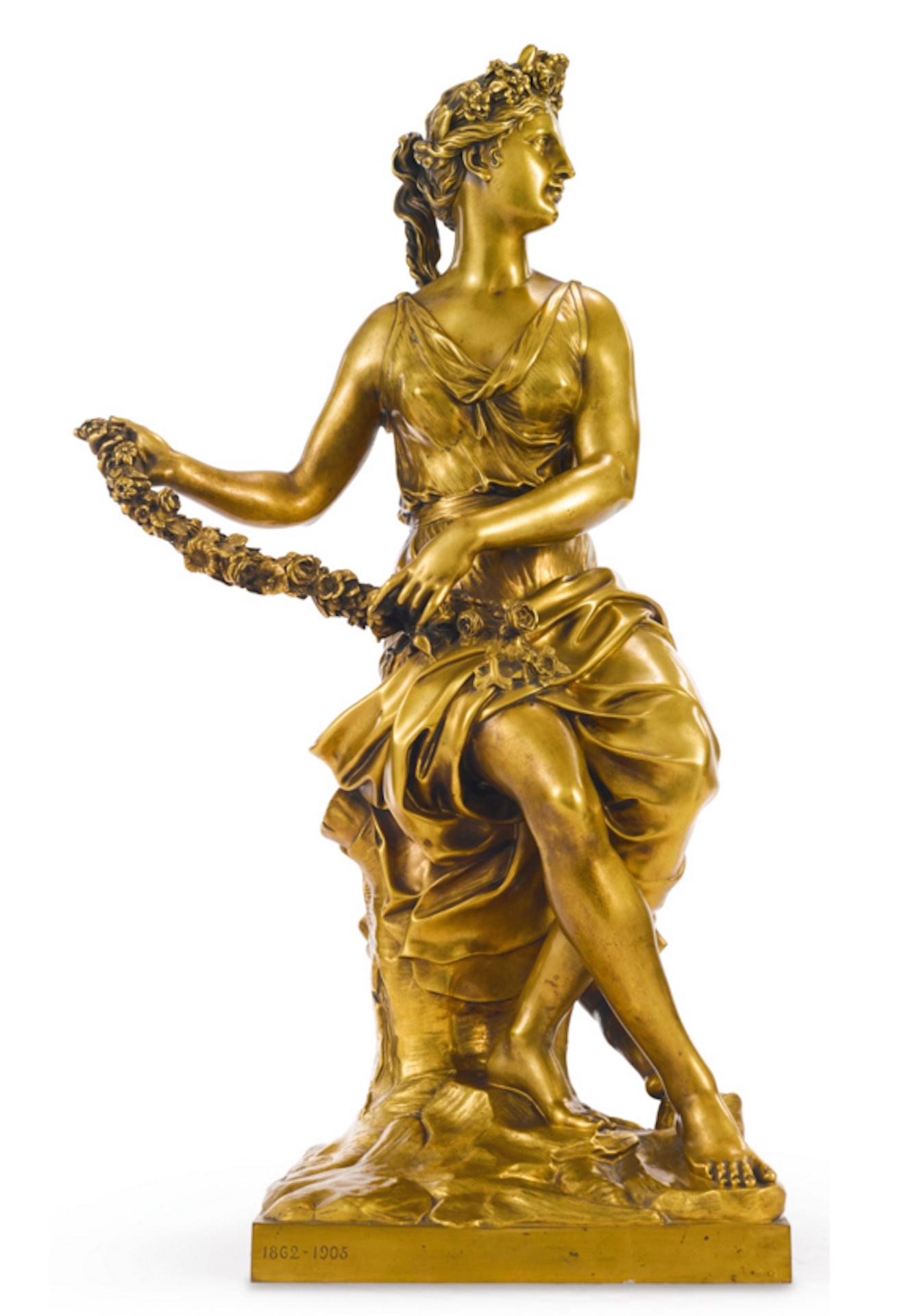Want more images or videos?
Request additional images or videos from the seller
1 of 9
Jean-Baptiste CarpeauxSuzanne Surprisecirca 1875
circa 1875
About the Item
"Suzanne Surprise" by Jean-Baptiste Carpeaux (1827-1875)
Terra cotta
"Propriété Carpeaux"
Marked with the stamp ‘Propriété Carpeaux’ with the Imperial Eagle and the stamp 'Atelier et Dépôt Auteuil Paris'.
Made during Carpeaux' lifetime or shortly after his death
France
circa 1875-1880
height 64 cm
A similar model is reproduced in « Jean-Baptiste Carpeaux sculpteur, catalogue raisonné de l’œuvre édité », Exposition du Musée des Beaux-Arts de Carcassonne, 2003, page 96.
Biography :
Jean-Baptiste Carpeaux (1827-1875) grew up in a modest family of workers in Valenciennes. He liked to draw and wanted to study sculpture against the will of his father. At the Academy of the city, he followed René Fache's sculpture classes and Bernard's architecture classes. Arrived in Paris in 1838 with his family, Carpeaux received a first training in drawing and modeling at the Little School. In 1844, he entered the School of Fine Arts in Paris in the studio of François Rude. Ten years later, he won the Prix de Rome. His arrival in the Italian capital was deferred for a year, the artist having to complete several orders. Carpeaux moved to the villa Medici in January 1856 and studied the great masters: Raphael, Michelangelo. He travelled to Italy where he drew his taste for movement and spontaneity. From his Italian stay, he sculpted three shipments, the Little Pouter, the Fisherman with the shell and his Ugolin surrounded by his four children.
In 1862, as he returned to Paris, Carpeaux was introduced to the imperial court by his friend and patron, Eugene Halwin Piennes, soon chamberlain of the Empress. He sculpted the same year a bust of Princess Mathilde whom allowed him to obtain several orders from the Emperor Napoleon III. But each of his works, in which his naturalist conceptions and his desire to recreate the movement inspired by the Baroque style, were the subject of controversy. Carpeaux took part in the exterior decoration of the Flore pavilion at the Louvre Palace (The Triumph of Flora, considered too sensual), and the opera newly built by Garnier, with a high relief La Danse, indignant to the public by his freedom and his realism.
He collaborated with the architect Gabriel Davioud for his latest work, the Fountain of the Four Parts of the World, also known as Fontaine de l'Observatoire in Paris. The last years of his life were dark. The war and the defeat of 1870 dried up the orders. At the same time, Carpeaux developed, with respect to his wife, an unhealthy jealousy that led to the separation of the couple in 1874. Under the influence of his parents, short of money, he abandoned the direction of his workshop to his brother. In 1875, he died at the age of forty-eight, after a terrible suffering due to bladder cancer. Jean-Baptiste Carpeaux, very attached to his hometown, bequeathed part of his works to the Museum of Fine Arts of Valenciennes.
- Creator:Jean-Baptiste Carpeaux (1827 - 1875)
- Creation Year:circa 1875
- Dimensions:Height: 25.2 in (64 cm)Width: 10.24 in (26 cm)Depth: 7.88 in (20 cm)
- Medium:
- Movement & Style:
- Period:
- Condition:
- Gallery Location:PARIS, FR
- Reference Number:

About the Seller
5.0
Vetted Seller
These experienced sellers undergo a comprehensive evaluation by our team of in-house experts.
Established in 1992
1stDibs seller since 2023
Typical response time: 1 to 2 days
- ShippingRetrieving quote...Ships From: PARIS, France
- Return PolicyA return for this item may be initiated within 3 days of delivery.
More From This SellerView All
- Young woman wearing a shawlBy Albert-Ernest Carrier-BelleuseLocated in PARIS, FRBust of a young woman wearing a shawl by Albert-Ernest Carrier-Belleuse (1824-1887) Terracotta bust Raised on a in blackened wood pedestal signed "A. Carrier " France circa 1860 total height 41 cm width 24 cm depth 17 cm Biography : Albert-Ernest Carrier de Belleuse known as Carrier-Belleuse (1824-1887) was one of the most prolific artists of the century and had the greatest successes under the Second Empire, enjoying the personal support of Napoleon III. His work was greatly influenced by the style of the Italian Renaissance and that of the 18th century, which he helped to bring up to date. In 1837, the young Carrier-Belleuse apprenticed in the workshop of the engraver Bauchery. He was admitted soon after to the goldsmith Jacques Henri Fauconnier. Through François Arago, he met the sculptor David d'Angers who facilitated his admission to the School of Fine Arts. Carrier-Belleuse entered it in 1840. Noted for his skill by the great bronze companies in Paris such as Barbedienne and Denière, he soon received numerous orders for models for candelabras, pendulums, fittings for fireplaces, etc. In 1848, probably at the initiative of François Arago, who became head of state, he received his first public order for a small statue of "Mademoiselle Rachel singing La Marseillaise". In 1851, he appeared for the first time at the Salon of French Artists, where he presented two bronze medallions. From 1851 to 1855, Carrier-Belleuse stayed in England, in Stoke-on-Trent where he served as director of the modeling and drawing school of the Minton house, a large porcelain manufacturer. Back in France, Carrier-Belleuse moved to Paris in a large workshop located 15 rue de la Tour d´Auvergne. From 1857, he made regular sendings to the Salon and became famous thanks to the success of large marbles, such as the "Bacchante" exhibited at the Salon in 1863, and acquired by Napoleon III, "Angelica" (1866) or even "Hebe asleep" (1869). At the Salon of 1867, his group entitled "Messiah" earned him the medal of honor of sculpture. It was acquired by the State to adorn the Chapel of the Virgin in the Saint-Vincent-de-Paul church. Carrier-Belleuse acquired a great reputation in parallel for his terracotta busts which, in many respects, recall those of 18th century artists. He made portraits of a large number of celebrities of his time. He produced, among others, the busts of Napoleon III, Renan, Thiers, Grévy, Arago, Marguerite Bellanger, Théophile Gautier, Honoré Daumier, Delacroix, Hortense Schneider, Réjane… He also modelled numerous busts of mythological inspiration and historical and artistic portraits like Marie Stuart...Category
1860s French School Figurative Sculptures
MaterialsTerracotta
- Torso of a WomanLocated in PARIS, FRTorso of a Woman by Marcel GIMOND (1894-1961) Avery fine nuanced brown chamotte sandstone sculpture raised on a dark grey marble base signed on the arm with the monogram "MG" for Ma...Category
1920s French School Figurative Sculptures
MaterialsTerracotta
- ParrotletLocated in PARIS, FRParrotlet by Armand PETERSEN (1891-1969) & SEVRES Manufacture Sculpture in white paste porcelain Signed « A. Petersen » Old edition artwork. Stamped by the porcelain manufacture of ...Category
1930s French School Figurative Sculptures
MaterialsPorcelain
- Ape riding on a GnuBy Antoine-Louis BaryeLocated in PARIS, FRApe riding on a Gnu by Antoine-Louis BARYE (1796-1875) A bronze group with a nuanced dark green patina signed "Barye" on the base Old cast probably by Brame France circa 1890 heig...Category
1890s French School Figurative Sculptures
MaterialsBronze
- PheasantBy François PomponLocated in PARIS, FRPheasant by François Pompon (1855-1933) Exceptional bronze with old gilded patina Cast by Valsuani Period cast France circa 1930 height 8,2 cm length 14,2 cm width 3,6 cm A simila...Category
1930s French School Figurative Sculptures
MaterialsBronze
- Man's head wearing glassesLocated in PARIS, FRMan's head wearing glasses by Laurent Belloni (né En 1969) Bronze cast with a nuanced black patina Signed "Belloni" on the base Foundry mark "Susse fondeur Paris", and foundry stam...Category
1990s French School Figurative Sculptures
MaterialsBronze
You May Also Like
- L'AiglonBy Louis OuryLocated in Paris, FRLouis Oury (1867 - 1940) L’Aiglon, 1899 Terracotta with polychromatic patina Signed on the shoulder and Seal from Goldscheider on the reverse Dimensions : 65 x 40 x 30 cm (25 x 15 3/...Category
19th Century French School Figurative Sculptures
MaterialsTerracotta
- Flora et L'amour ou HamadryadeBy Ferdinand BarbedienneLocated in Tallinn, EEFerdinand Barbedienne (1810 - 1892) Antoine Coysevox, after (France, 1640-1720) Flora et L'amour ou Hamadryade Inscribed 'A. COYSEVOX. F. 1710'. With foundry mark 'F. BARBEDIENNE...Category
Late 19th Century French School Figurative Sculptures
MaterialsBronze
- VictoireLocated in LE HAVRE, FRJacques COQUILLAY (né en 1935) Victoire Original bronze Size : 105 x 22 x 20 cm Copy No. 1/8 Signature and numbered on the base. Original bronze m...Category
Early 2000s French School Nude Sculptures
MaterialsBronze
- Danse au TambourinBy Albert-Ernest Carrier-BelleuseLocated in Tallinn, EEAlbert-Ernest Carrier-Belleuse 1824 - 1887 Danse au Tambourin signed Carrier Belleuse bronze height: 72.4cm. diameter: 26.7cm. Provenance Important American collection. The present ...Category
Mid-19th Century French School Figurative Sculptures
MaterialsBronze
- Unknown womanLocated in Täby, SEInspired by the head of Apollo by Antoine Bourdelle. A woman with strong firm but still vulnerable expresson.Category
1980s French School Figurative Sculptures
MaterialsBronze
- Friendship, comfort: hand modelled sculpture by Polish Jewish French artistLocated in Norwich, GBAn extraordinary depiction of friendship and comfort by Polish Jewish sculptor Michal Michael Milberger. Milberger was born in Warsaw in 1922. His artis...Category
Late 20th Century French School Figurative Sculptures
MaterialsPlaster
Recently Viewed
View AllMore Ways To Browse
Italian Capital
Model 1879
Fontaine Antique
Antique Emperor Sculpture
Sculpture Black Couple
Medici Sculpture
Michelangelo Drawings
Sculpted Terracotta
Figurative Sculpture Emperor
Antique Architectural Terracotta
Imperial Eagle
Architecture Terra Cotta
Terra Cotta And Architectural
The Last Empress
Medici Four
Terra Bust
Terra Cotta Bust
Emperor Empress Art


